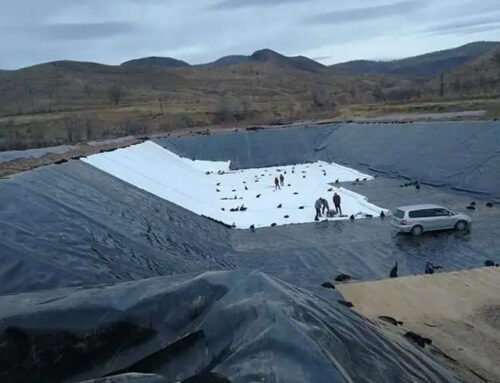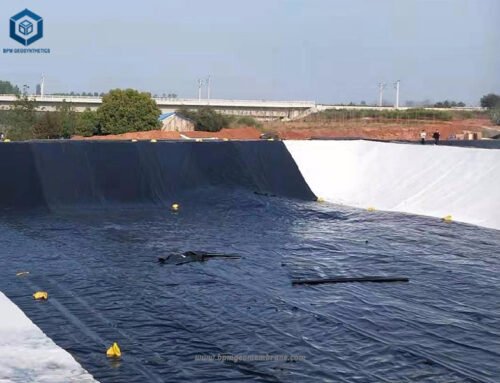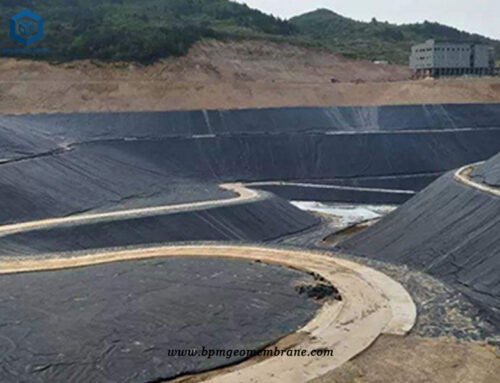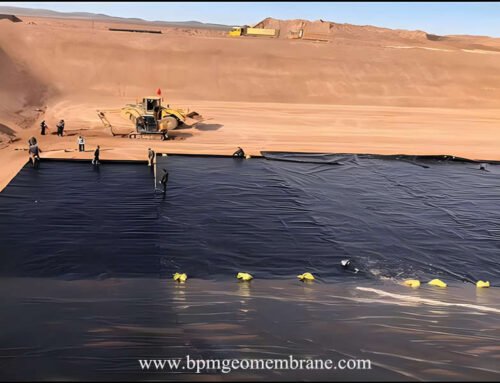HDPE Geomembrane Material, the primary components of which consist of high-density polyethylene (HDPE) and medium-density polyethylene (MDPE), can be categorized into two types: smooth surface and rough surface. The rough surface variant can be further divided into single rough surface and double rough surface geomembranes.The selection of raw materials for the geomembrane adheres to strict standards, particularly in accordance with the American environmental protection geomembrane specifications. Currently, most domestic mine engineering designs require compliance with the American standard geomembrane criteria. In comparison to regular geomembranes, HDPE Geomembrane Material designed for mining applications generally exhibits higher tensile strength, greater elongation, improved resistance to acids, and an extended service life.
Case Study
- Location: Africa
- Product: Geomembrane
- Application: Mining Seepage Prevention Project
Issue
A mining seepage prevention project is underway in Africa, and the client requires 1.5mm HDPE geomembrane material. Geomembranes possess exceptional anti-seepage properties, effectively preventing the contamination of the environment in mining operations by isolating and preventing the spread of harmful substances such as wastewater, toxic materials, and chemicals. To ensure the success of the mining seepage prevention project, it is crucial to select an appropriate installation method and enhance the waterproofing construction procedures. Following discussions with the designer, the client has opted to utilize 1.5mm HDPE geomembrane material that complies with the ASTM standard.
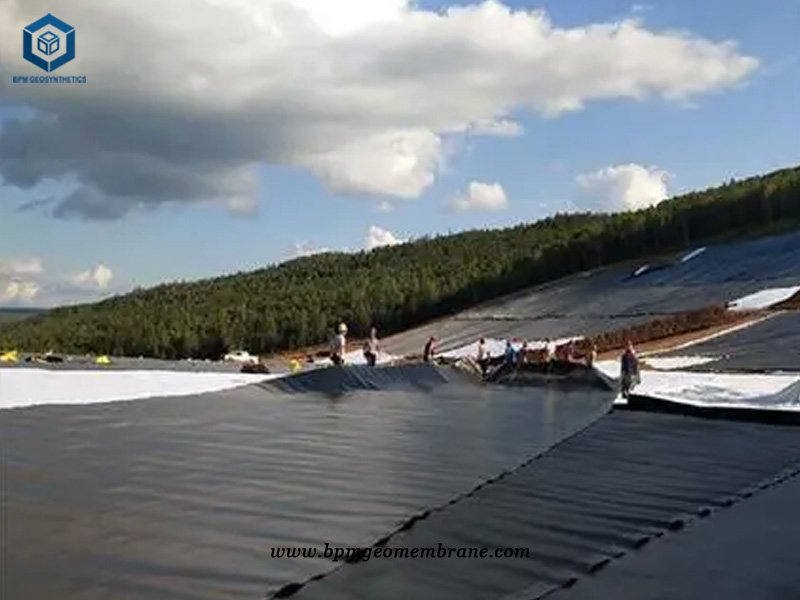
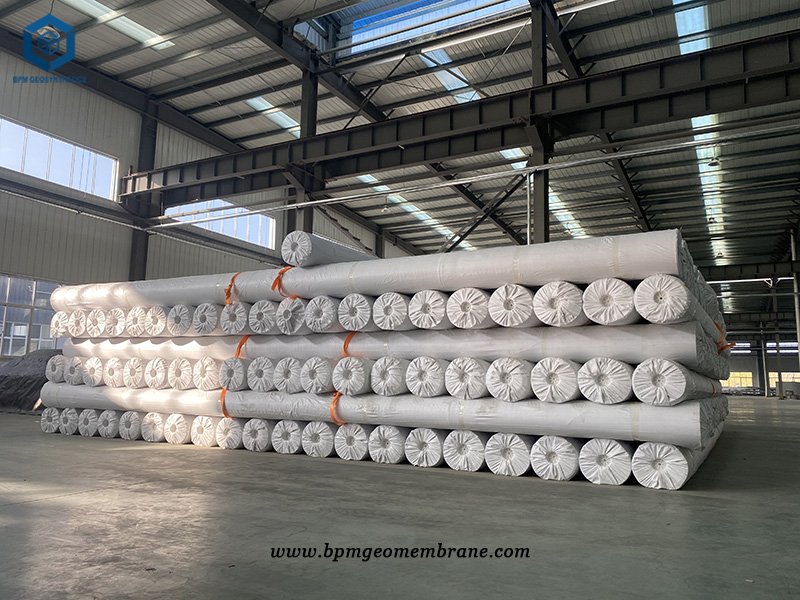
Solution
The laying method of HDPE geomembrane:
The specific steps for tailings pond seepage prevention engineering are as follows:
1. Surface Treatment of Tailings Pond
Firstly, the surface of the tailings pond is leveled, and obstacles such as weeds and stones are removed. Then, the soil surface is cleaned to ensure that the HDPE geomembrane material can fully adhere to the soil surface. In addition, measurements and markings are made to determine the laying direction of the HDPE geomembrane material and the edge treatment method.
2. HDPE Geomembrane Material Laying
A layer of 1.5mm thick HDPE geomembrane material is covered on the surface of the tailings pond, and the HDPE geomembrane material is fixed to the soil surface by clamping. During the laying process, attention should be paid to avoid damaging the geomembrane, and prevent sharp objects, sand, stones, and other items from scratching the surface of the geomembrane.
3. Cushion Layer Laying
To safeguard the HDPE geomembrane material, a protective system consisting of a 2-meter-thick clay cushion layer and a 0.5-meter-thick gravel cushion layer is implemented. The clay cushion layer is a blend of clay, sand, water, and other additives, exhibiting excellent compaction and adhesion properties. It serves to enhance the stability and integrity of the installation. On the other hand, the gravel cushion layer is a combination of gravel and fine sand, designed to provide efficient drainage and ensure structural stability. This layered arrangement offers mechanical protection against potential damage and shields the geomembrane from harmful UV radiation.
4. Drainage System Installation
To facilitate the removal of accumulated water within the tailings pond, drainage ditches and drainage pipes are strategically installed surrounding the area. These drainage systems enable the efficient discharge of water from the pond to a dedicated sewage treatment facility. The collected water undergoes proper treatment processes to address any potential pollutants or contaminants present.
5. Monitoring System Installation
To effectively monitor the hydrogeological conditions and pressure fluctuations within the tailings pond, percolation monitoring wells and pressure monitoring wells are strategically installed. These wells serve as essential components of the monitoring system, providing valuable data on the water percolation and pressure dynamics within the pond. It is crucial to design and arrange the monitoring system in accordance with the specific conditions of the tailings pond to ensure the accuracy and reliability of the collected data. This tailored approach guarantees the effectiveness of the monitoring efforts and enables informed decision-making regarding the management and maintenance of the tailings pond.
Benefits
What are the advantages of using HDPE geomembrane in mining projects?
HDPE (High Density Polyethylene) geomembrane is a commonly used material in mining projects for its many advantages, including:
1.Excellent Chemical Resistance
HDPE geomembranes have excellent resistance to a wide range of chemicals, including acids, alkalis, and hydrocarbons. This makes them ideal for use in mining projects where exposure to potentially harmful chemicals is a concern.
2.High Tensile Strength and Puncture Resistance
HDPE geomembranes have high tensile strength and puncture resistance, which means they can withstand the stresses and strains of mining operations, including heavy equipment and sharp rocks.
3.Good Flexibility and Elongation Properties
HDPE geomembranes have good flexibility and elongation properties, which enables them to conform to uneven surfaces and adapt to ground movement and settling.
4.UV Resistance
HDPE geomembranes have good resistance to UV radiation, which makes them suitable for use in mining projects in areas with high levels of sunlight exposure.
5.Easy Installation and Maintenance
HDPE geomembranes are easy to install and maintain, which can help save time and money during the construction and operation of mining projects.
6.Cost-effective
HDPE geomembranes are cost-effective compared to other types of geomembranes, which can help reduce the overall cost of mining projects.
Overall, the use of HDPE geomembranes in mining projects provides a reliable, effective, and cost-efficient solution for preventing environmental contamination and protecting water resources.
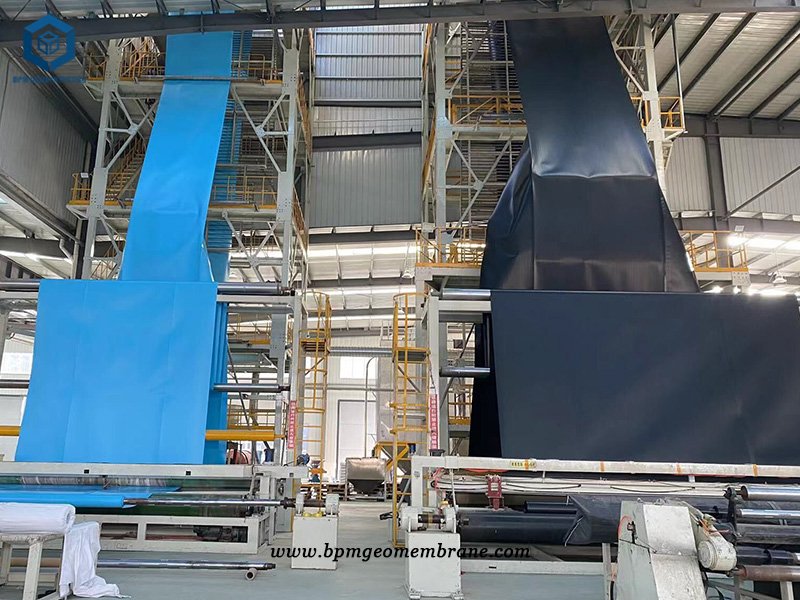

Summary
The application of geomembranes in mining is very extensive, but the construction requirements are high, and design and construction need to be carried out according to specific conditions to ensure the seepage prevention effect.
Specifications of HDPE Geomembrane Material for Mining Seepage Prevention Project in Africa
- Total quantity–30,000 squares meters
- HDPE geomembrane – 1.5mm
- Each roll size is 5.8m*50m
About BPM
BPM has been specializing in delivering complete line of geosynthetics products and solutions to worldwide customers since its foundation in 2007. BPM had provided many types of effective and state of the art geomembranes, geotextiles, geocells, geosynthetic clay liners (GCLs), drainage boards, geogrids to over 81 countries. Our main customers are from Australia, Mexico, Ecuador, Brazil, Pakistan, Bangladesh, Thailand, Vietnam, Malaysia, Indonesia, Singapore, Philippines, UAE, Saudi Arabia, Qatar, Kenya, Ghana, Ethiopia, South Africa,Mongolia, etc.
BPM is not only manufacturing best quality geosynthetic products but also providing professional design and installation service. OEM, ODM, custom development and fabrication are also available. If you have any questions or inquiries, please fill and submit the following form, we will reply as soon as possible.

